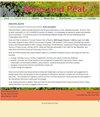拉脱维亚斯莱特雷国家公园的生物基因组价值:特别是沙丘间的沼泽
IF 1.5
4区 环境科学与生态学
Q4 ENVIRONMENTAL SCIENCES
引用次数: 6
摘要
欧洲的沙丘间湿地拥有许多红名单物种,因为它们是营养非常贫乏的生态系统。这些湿地大多在地质上非常年轻,没有或很少形成泥炭。在斯利特尔国家公园,众多的沙丘间湿地相对古老,有4500年的历史,大多数沼泽群落都是泥炭形成的,它们保存得很好。然而,保护沼泽的水文系统在很大程度上是未知的。在本研究中,我们分析了128个沙丘沼泽的植被相关物,以评估生态沼泽类型的变化。我们还进行了几项短期研究,以深入了解泥炭的发展和维持沼泽的水文条件。我们描述了26个沙丘山谷中的泥炭剖面、测得的温度剖面和电导率。我们区分了三个主要植被单元和十个子单元,代表了泥炭形成的不同阶段。根据电导率和温度分布,我们假设这些沼泽是由当地和更大区域的地下水流维持的,其中后者可能受到人为影响的干扰,主要是在国家公园外。该公园的重要性是通过将其与波罗的海沿岸所有国家的湿地物种清单进行比较来评估的。在欧洲范围内,斯莱特国家公园的沙丘间湿地非常重要,因为它们代表了景观范围内淤泥形成的发达例子,而在欧洲大部分地区,这些湿地很少或由于土地集约利用而灭绝。本文章由计算机程序翻译,如有差异,请以英文原文为准。
The biocenotic values of Slitere National Park, Latvia: With special reference to inter-dune mires
Inter-dune wetlands in Europe harbour many Red List species because they are very nutrient-poor ecosystems. Most of these wetlands are geologically very young and no or little peat formation has occurred. In Slitere National Park the numerous inter-dune wetlands are relatively old, up to 4500 years old, and most mire communities are peat forming and they are well preserved. However, the hydrological systems that have conserved the mires are largely unknown. In the present study we analysed 128 vegetation relevees of dune mires in order to assess the variation in ecological mire types. We also carried out several short-time studies to get an insight into the peat development and hydrological conditions that sustain the mires. We describe peat profiles and measured temperature profiles and electrical conductivity in 26 dune valleys. We distinguished three main vegetation units and ten sub-units, representing various stages in peat formation. Based on electrical conductivity and temperature profiles we hypothesised that the mires were sustained by both local and more regional groundwater flows, of which the latter were possibly disturbed by anthropogenic influences, mainly outside the National Park. The importance of the Park was evaluated by comparing it to species lists of wetlands from all countries bordering the Baltic Sea. On the European scale the inter-dune wetlands of Slitere National Park are very important because they represent well-developed examples of mire formation on a landscape scale, which elsewhere in most of Europe are rare or have become extinct due to intensive land use.
求助全文
通过发布文献求助,成功后即可免费获取论文全文。
去求助
来源期刊

Mires and Peat
ENVIRONMENTAL SCIENCES-
CiteScore
2.30
自引率
16.70%
发文量
0
审稿时长
33 weeks
期刊介绍:
Mires and Peat is a peer-reviewed internet journal focusing specifically on mires, peatlands and peat. As a truly “free-to-users” publication (i.e. NO CHARGES to authors OR readers), it is immediately accessible to readers and potential authors worldwide. It is published jointly by the International Peatland Society (IPS) and the International Mire Conservation Group (IMCG).
Mires and Peat is indexed by Thomson Reuters Web of Science (2017 Impact Factors: 1.326 [two-year] and 1.638 [five-year]), Elsevier Scopus, EBSCO Environment Complete, CABI Abstracts, CSA Proquest (including their Aquatic Science and Fisheries Abstracts ASFA, Ecology, Entomology, Animal Behavior, Aqualine and Pollution databases) and Directory of Open Access Journals (DOAJ). Mires and Peat also participates in the CABI Full Text Repository, and subscribes to the Portico E-journal Preservation Service (LTPA).
Mires and Peat publishes high-quality research papers on all aspects of peatland science, technology and wise use, including:
ecology, hydrology, survey, inventory, classification, functions and values of mires and peatlands;
scientific, economic and human aspects of the management of peatlands for agriculture, forestry, nature conservation, environmental protection, peat extraction, industrial development and other purposes;
biological, physical and chemical characteristics of peat; and
climate change and peatlands.
Short communications and review articles on these and related topics will also be considered; and suggestions for special issues of the Journal based on the proceedings of conferences, seminars, symposia and workshops will be welcomed. The submission of material by authors and from countries whose work would otherwise be inaccessible to the international community is particularly encouraged.
 求助内容:
求助内容: 应助结果提醒方式:
应助结果提醒方式:


